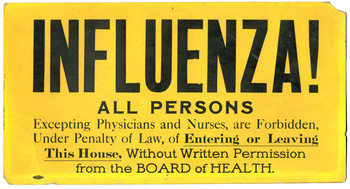#1 THE 1918 INFLUENZA EPIDEMIC IN EDWARDS COUNTY

The library is closed to the public, but your library staff is still working (alone) on things that will improve our resources and service. Besides administrative duties, I am working on our local history archive and plan to write an article for the Edwards County Sentinel and this blog drawn from that archive.
For this first one, I thought it would be appropriate to research the influenza epidemic of 1918 in the Edwards County newspapers. The current pandemic is often being compared to this “Spanish Flu” which in reality started right here Kansas.
Soldiers at Fort Funston (part of Fort Riley) were given a few days leave in March before being sent oversea to fight in WWI. Some went home to Hesston where they contracted the flu and took it back to Fort Funston. The disease quickly spread through the troops and soon 200,000 men carried it to other bases, overseas to Europe, and around the world.
It is estimated that 50 million people died of the influenza in 1918 and 1919, with 675,000 deaths in the U.S. According to Kansapedia, “The Spanish influenza was responsible for twice the number of casualties (both killed and wounded) of the United States in World War I, which totaled near 323,000. A third and final wave of the epidemic hit in the spring of 1919, and many reported that it was so severe that people could wake up healthy and be dead by nightfall.” (The second wave was in the fall of 1918.)
Hundreds of deaths were reported in Kansas and health officials closed many Kansas cities, schools, churches, theaters and other public gatherings. As I read through the local papers of the time, I found many reports like this one: “The families of Adam Stegman, A. Burkhart, and J. Jensen are all having a siege of influenza, several members of each household being sick.” (KInsley Graphic, March 20, 1919)
The Kinsley Mercury of March 6, 1919 wrote that: “The flu epidemic is getting a good start in Offerle. Heretofore the Offerle people have been very lucky in not spreading the flu but we can not say that any more as it is quite common. Some of the flu patients are Mr. and Mrs. E.H. Renfro, Reuben Miller, Mrs. Jess ward, Mrs. John Lobil, Sophia Rabey, Earl Hedges and Vernon Oliphant.”
“Strict quarantine regulations will be enforced here until the influenza abates.” reported the Kinsley Graphic of December 12, 1918. Some examples of the rules were: All cases must be reported by doctor or the head of household. The house must be placarded. All members of the family not engaged in imperative business must remain on the premises. All patients afflicted with the disease are to be strictly isolated.
We can be grateful today that our rules do not include a warning reference to a world war. “Look well to your cough and smother your sneeze! For the Kaiser laughs when you spread disease. (Kinsley Graphic, October 19, 1918)
To be placarded meant the family had to post a quarantine sign on the house. Like now, the editor of the Graphic found a spot of humor amidst the serious situation (December 19, 1918)
“One of Kinsley’s automobile dealers has a family of five small children, and they are the kind that not only bless their own home but are a constant source of enjoyment to their neighbors.
“A few days ago the ever prevalent ‘flu’ sign appeared by the front door and caused much worry to those who saw it. Shortly following, Mr. Auto-man was asked the common question: ‘Who has it?’
“He stoutly contended they were all well, when he left shortly after breakfast, but hastened home to make sure of his assertion.
“He lined his family up. No fever, no aches—everybody fine. Whereupon he began to inquire of his young hopefuls about the ‘flu’ card.
“’Well’ said one, ‘we found this one, and most everybody had one, so we just tacked it up’ –and they did.”
What Nell Lewis (Woods) wrote in her Kinsley Mercury column “Down Our Way” on January 30, 1919 might ring true in your “stay home” household today. “One thig, the screen door that had been broken all summer was repaired, and some other things that had been neglected got attention during our hibernation.”
When this pandemic is over, we can hope that history records us in the same manner that the Kinsley Graphic did Fellsburg. “Fellsburg gave a fine example of neighborliness in the recent epidemic of influenza from which the town and surrounding country suffered. There were one hundred cases in and about the village, no doctors or nurses there, and the roads so nearly impassable from the snow that it was very hard for doctors to reach them. The neighbors cared for each other, taking turns nursing the sick, and doing the necessary work of caring for the stock on the farms. There was but one death in the one hundred cases of flu, and we are wondering if any other place has so good a record, in the recent terrible epidemic.”
Reading in these old newspapers can be quite entertaining and educational. The Kansas Historical Society makes them freely available online to all Kansas residents Click here to register: https://www.kshs.org/ancestry/drivers/dlverify
